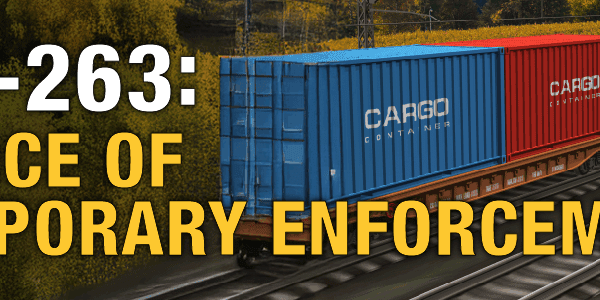
Hazmat Certification Under Placarding Exemption
The US DOT recently issued a “Letter of Interpretation” (LoI) regarding the lack of a need for a driver to have a hazmat (hazardous materials) endorsement on the CDL (Commercial Driver’s License) when transporting Class 9 hazmat within the US, despite the presence of Class 9 placards.
Changing Modes without Removing Placards
This situation is likely to occur when foreign shipments arrive which did not have the equivalent to the US 49 CFR §172.504(f)(9) conditional exception for Class 9 placarding, and are to be transported to their US destination.
An example would be if a Class 9 consignment arrives by vessel, which has placarding in conformance with the IMDG Code, and is picked up for road transport without removing the placards.
Even if the placards are not removed, there is not a requirement for the hazmat-endorsed CDL (equivalent to a TDG training certificate- for readers North of the 49th, metonymically speaking).
Note that, despite the exception for an actual Class 9 placard, §172.504(f)(9) does require bulk packages to be marked with at least the UN number.
Key to the Endorsement Exemption
49 CFR §383.93(b)(4) invokes the need for a hazmat CDL when the definition of hazmat in 383.5 is met. For substances defined as hazardous in 49 U.S. Code §5103(a) and (other than infectious substances/ biotoxins in 42 CFR §73) requiring placards, the CDL endorsement is required.
Thus, for most substances, an exception from placarding exempts the driver from having the endorsement. This is summarized in LoI 18-0015 issued to the IVODGA (International Vessel Operators Dangerous Goods Association) May 17, 2018.
This Exemption Stops at the Northern (or Southern, from Alaska!) Border
Note that Transportation of Dangerous Goods Regulations (TDGR) will not accept this approach on entry to Canada. TDGR 9.1(2)(d) refuses reciprocity permission for things done by 49 CFR “exception”, unless they have an equivalent in Canada. TDGR 6.4 allows a US-endorsed CDL to serve for the training certificate required under 6.1.
Note that 6.1 does not provide an exemption from training based on general placarding rules, etc. So, the driver entering Canada, subject to specific Canadian exemptions (e.g. Special Cases or Special Provisions), would be expected to have endorsed CDL as well as the vehicle meeting Class 9 full placarding requirements. There is no TDGR equivalent to the US Class 9 placarding exception.
Any transportation activity involving dangerous goods, unless specifically exempt, requires a trained person with a certificate. Despite the common misconception that items covered by an exemption are “not DG”, in practice very few exemptions free the subject from classification. So if they are classified, they are still DG – freedom from training will only apply if the exemption excludes the application of Part 6. Perhaps this will be expanded in a future blog…






 ICC USA
ICC USA ICC Canada
ICC Canada